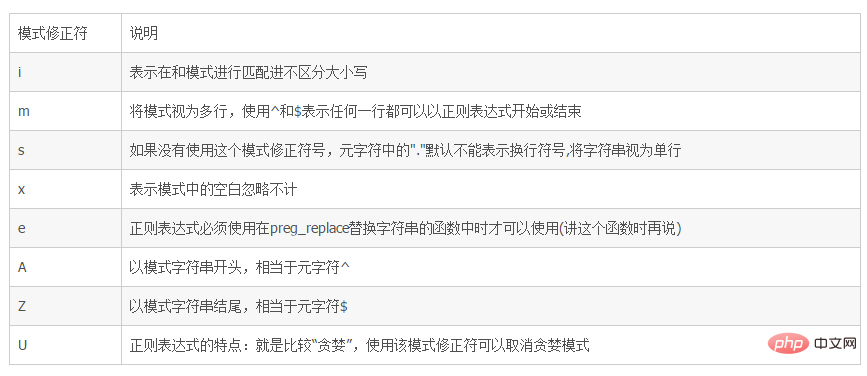 Backend Development
Backend Development
 PHP Tutorial
PHP Tutorial
 Detailed explanation of the role of pattern modifiers in regular expressions
Detailed explanation of the role of pattern modifiers in regular expressions
Detailed explanation of the role of pattern modifiers in regular expressions

Detailed explanation of the role of pattern modifiers in regular expressions (i, g, m, s, x, e)
What are pattern modifiers?
1. Pattern modifiers are just a few letters. We can use one at a time or multiple consecutively in each regular expression. Each one has a certain meaning.
2. The pattern modifier is used to tune the entire regular expression, and can also be said to be an extension of the regular expression function.
Remember the formula of regular expressions? '/Atoms and Metacharacters/Pattern Modifier', where the forward slash is the boundary character.
The composition of pattern modifiers
Pattern modifiers are letters, but these have special meanings in the application of pattern modifiers. Let me take a look at what pattern modifiers are available. Please see the following table:

Since i means that the match is not case-sensitive, in the following example, we no longer To demonstrate, let's look at examples of other pattern modifiers.
1, mode modifier m.
The code is as follows:
<?php
$pattern = '/^abc/m';
$string = 'bcd
abc
cba';
if (preg_match($pattern, $string, $arr)) {
echo "正则表达式<b>{$pattern}</b>和字符串<b>{$string}</b>匹配成功<br>";
print_r($arr);
} else {
echo "<font color='red'>正则表达式{$pattern}和字符串{$string}匹配失败</font>";
}
?>The matching result is successful. Note: When we use the pattern modifier m, we treat the matching string as multiple lines instead of the default single line, so as long as any line starts with abc, the match will be successful. However, if there are spaces in front of the matching lines, they will not be matched! Unless the matching mode of the regular expression is modified.
2, mode modifier s.
The code is as follows:
<?php
$pattern = '/a.*c/s';
$string = 'adsadsa
c';
if (preg_match($pattern, $string, $arr)) {
echo "正则表达式<b>{$pattern}</b>和字符串<b>{$string}</b>匹配成功<br>";
print_r($arr);
} else {
echo "<font color='red'>正则表达式{$pattern}和字符串{$string}匹配失败</font>";
}
?>This time the matching demerit was also successful. If you remove the pattern modifier s in the above example, the match will fail. Because the pattern modifier s treats the matched string as a single line, at this time, the "." in the metacharacter can represent a newline symbol.
3, mode modifier x.
The code is as follows:
<?php
$pattern = '/a c/x';
$string = 'a c';
if (preg_match($pattern, $string, $arr)) {
echo "正则表达式<b>{$pattern}</b>和字符串<b>{$string}</b>匹配成功<br>";
print_r($arr);
} else {
echo "<font color='red'>正则表达式{$pattern}和字符串{$string}匹配失败</font>";
}
?>The matching result this time was failed. Because we used the pattern modifier x to cancel the spaces in the pattern. Note: We cannot use the pattern modifier to cancel the white space represented by \s.
4, mode modifier A.
The code is as follows:
<?php
$pattern = '/ac/A';
$string = 'acahgyghvbm';
if (preg_match($pattern, $string, $arr)) {
echo "正则表达式<b>{$pattern}</b>和字符串<b>{$string}</b>匹配成功<br>";
print_r($arr);
} else {
echo "<font color='red'>正则表达式{$pattern}和字符串{$string}匹配失败</font>";
}
?>The meaning of the regular expression is to match the string starting with ac, and the result is successful.
The pattern modifier Z represents a match that ends in a string. The usage is the same as A. We will not demonstrate it again.
5, mode modifier U.
This pattern modifier is very important! In regular expressions, it itself is "greedy". So what is greedy mode? Greedy mode means that by default, the regular expression will continue to try subsequent matches after finding the first match. If a match can be found, it will match the largest range of strings. But sometimes this is not the result we want, so we need to cancel greedy mode.
Let’s look at an example of greedy mode first:
The code is as follows:
<?php
$pattern = '/<b>.*<\/b>/';
$string = '<b>welcome</b> <b>to</b> <b>phpfuns</b>';
if (preg_match($pattern, $string, $arr)) {
echo "正则表达式<b>{$pattern}</b>和字符串<b>{$string}</b>匹配成功<br>";
print_r($arr);
} else {
echo "<font color='red'>正则表达式{$pattern}和字符串{$string}匹配失败</font>";
}
?>The original intention of this example is to match welcome, but the result is to match the entire character of welcome to phpfuns string (note that our string 'welcome to phpfuns', its beginning and end exactly constitute the pattern matching of the regular expression, so the match is successful), this is the greedy mode of the regular expression. Of course, this is not the result we want.
Cancel the greedy mode
We can use the pattern modifier U and the metacharacter ? to cancel the greedy mode of the regular expression in two ways.
Mode modifier U cancels greedy mode
The code is as follows:
<?php
$pattern = '/<b>.*<\/b>/U';
$string = '<b>welcome</b> <b>to</b> <b>phpfuns</b>';
if (preg_match($pattern, $string, $arr)) {
echo "正则表达式<b>{$pattern}</b>和字符串<b>{$string}</b>匹配成功<br>";
print_r($arr);
} else {
echo "<font color='red'>正则表达式{$pattern}和字符串{$string}匹配失败</font>";
}
?>Metacharacter? Cancel greedy mode
The code is as follows:
<?php
$pattern = '/<b>.*?<\/b>/';
$string = '<b>welcome</b> <b>to</b> <b>phpfuns</b>dsadsadas';
if (preg_match($pattern, $string, $arr)) {
echo "正则表达式<b>{$pattern}</b>和字符串<b>{$string}</b>匹配成功<br>";
print_r($arr);
} else {
echo "<font color='red'>正则表达式{$pattern}和字符串{$string}匹配失败</font>";
}
?>The above is the detailed content of Detailed explanation of the role of pattern modifiers in regular expressions. For more information, please follow other related articles on the PHP Chinese website!

Hot AI Tools

Undresser.AI Undress
AI-powered app for creating realistic nude photos

AI Clothes Remover
Online AI tool for removing clothes from photos.

Undress AI Tool
Undress images for free

Clothoff.io
AI clothes remover

Video Face Swap
Swap faces in any video effortlessly with our completely free AI face swap tool!

Hot Article

Hot Tools

Notepad++7.3.1
Easy-to-use and free code editor

SublimeText3 Chinese version
Chinese version, very easy to use

Zend Studio 13.0.1
Powerful PHP integrated development environment

Dreamweaver CS6
Visual web development tools

SublimeText3 Mac version
God-level code editing software (SublimeText3)

Hot Topics
 1664
1664
 14
14
 1423
1423
 52
52
 1317
1317
 25
25
 1268
1268
 29
29
 1244
1244
 24
24
 PHP regular expression validation: number format detection
Mar 21, 2024 am 09:45 AM
PHP regular expression validation: number format detection
Mar 21, 2024 am 09:45 AM
PHP regular expression verification: Number format detection When writing PHP programs, it is often necessary to verify the data entered by the user. One of the common verifications is to check whether the data conforms to the specified number format. In PHP, you can use regular expressions to achieve this kind of validation. This article will introduce how to use PHP regular expressions to verify number formats and provide specific code examples. First, let’s look at common number format validation requirements: Integers: only contain numbers 0-9, can start with a plus or minus sign, and do not contain decimal points. floating point
 Master regular expressions and string processing in Go language
Nov 30, 2023 am 09:54 AM
Master regular expressions and string processing in Go language
Nov 30, 2023 am 09:54 AM
As a modern programming language, Go language provides powerful regular expressions and string processing functions, allowing developers to process string data more efficiently. It is very important for developers to master regular expressions and string processing in Go language. This article will introduce in detail the basic concepts and usage of regular expressions in Go language, and how to use Go language to process strings. 1. Regular expressions Regular expressions are a tool used to describe string patterns. They can easily implement operations such as string matching, search, and replacement.
 How to match timestamps using regular expressions in Go?
Jun 02, 2024 am 09:00 AM
How to match timestamps using regular expressions in Go?
Jun 02, 2024 am 09:00 AM
In Go, you can use regular expressions to match timestamps: compile a regular expression string, such as the one used to match ISO8601 timestamps: ^\d{4}-\d{2}-\d{2}T \d{2}:\d{2}:\d{2}(\.\d+)?(Z|[+-][0-9]{2}:[0-9]{2})$ . Use the regexp.MatchString function to check if a string matches a regular expression.
 How to validate email address in Golang using regular expression?
May 31, 2024 pm 01:04 PM
How to validate email address in Golang using regular expression?
May 31, 2024 pm 01:04 PM
To validate email addresses in Golang using regular expressions, follow these steps: Use regexp.MustCompile to create a regular expression pattern that matches valid email address formats. Use the MatchString function to check whether a string matches a pattern. This pattern covers most valid email address formats, including: Local usernames can contain letters, numbers, and special characters: !.#$%&'*+/=?^_{|}~-`Domain names must contain at least One letter, followed by letters, numbers, or hyphens. The top-level domain (TLD) cannot be longer than 63 characters.
 How to verify password using regular expression in Go?
Jun 02, 2024 pm 07:31 PM
How to verify password using regular expression in Go?
Jun 02, 2024 pm 07:31 PM
The method of using regular expressions to verify passwords in Go is as follows: Define a regular expression pattern that meets the minimum password requirements: at least 8 characters, including lowercase letters, uppercase letters, numbers, and special characters. Compile regular expression patterns using the MustCompile function from the regexp package. Use the MatchString method to test whether the input string matches a regular expression pattern.
 Chinese character filtering: PHP regular expression practice
Mar 24, 2024 pm 04:48 PM
Chinese character filtering: PHP regular expression practice
Mar 24, 2024 pm 04:48 PM
PHP is a widely used programming language, especially popular in the field of web development. In the process of web development, we often encounter the need to filter and verify text input by users, among which character filtering is a very important operation. This article will introduce how to use regular expressions in PHP to implement Chinese character filtering, and give specific code examples. First of all, we need to clarify that the Unicode range of Chinese characters is from u4e00 to u9fa5, that is, all Chinese characters are in this range.
 PHP regular expressions: exact matching and exclusion of fuzzy inclusions
Feb 28, 2024 pm 01:03 PM
PHP regular expressions: exact matching and exclusion of fuzzy inclusions
Feb 28, 2024 pm 01:03 PM
PHP Regular Expressions: Exact Matching and Exclusion Fuzzy inclusion regular expressions are a powerful text matching tool that can help programmers perform efficient search, replacement and filtering when processing text. In PHP, regular expressions are also widely used in string processing and data matching. This article will focus on how to perform exact matching and exclude fuzzy inclusion operations in PHP, and will illustrate it with specific code examples. Exact match Exact match means matching only strings that meet the exact condition, not any variations or extra words.
 PHP returns the string from the start position to the end position of a string in another string
Mar 21, 2024 am 10:31 AM
PHP returns the string from the start position to the end position of a string in another string
Mar 21, 2024 am 10:31 AM
This article will explain in detail how PHP returns the string from the start position to the end position of a string in another string. The editor thinks it is quite practical, so I share it with you as a reference. I hope you will finish reading this article. You can gain something from this article. Use the substr() function in PHP to extract substrings from a string. The substr() function can extract characters within a specified range from a string. The syntax is as follows: substr(string,start,length) where: string: the original string from which the substring is to be extracted. start: The index of the starting position of the substring (starting from 0). length (optional): The length of the substring. If not specified, then



